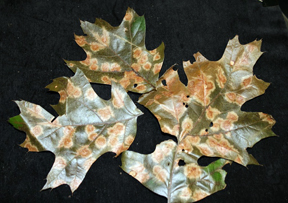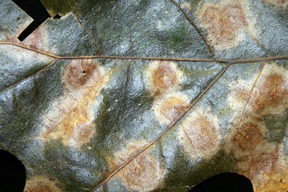Tubakia leaf spot of oak
Editor’s note: This article is from the archives of the MSU Crop Advisory Team Alerts. Check the label of any pesticide referenced to ensure your use is included.
The lab has received several oak samples in the past month with Tubakia leaf spot. Tubakia is a fungal pathogen that can cause leaf spotting on a range of trees and shrubs; oaks are most often affected. All oaks can be affected, but red oaks are reported to be particularly susceptible.
Tubakia
leaf spot symptoms typically don’t develop until midsummer. Note that
this is in contrast to oak anthracnose, which begins causing leaf blight
in late spring. Tubakia symptoms become more noticeable as the season
progresses. The recently submitted foliage had large, circular,
nickel-sized necrotic spots (see photos). Trees with heavily affected
foliage have an alarming brown appearance and may defoliate prematurely.
One interesting fact about this pathogen (if you like fungi trivia) is
that the fungus produces as many as four toxins that cause necrosis of
oak leaves. This explains why each leaf infection is surrounded by a
circle of necrotic tissue.
Tubakia leaf spot causes aesthetic damage to affected trees, but will
not cause tree death. For this reason, fungicide applications are not
recommended for landscape trees.
References
Disease of Trees and Shrubs, Sinclair and Johnson, Cornell University Press.



 Print
Print Email
Email




